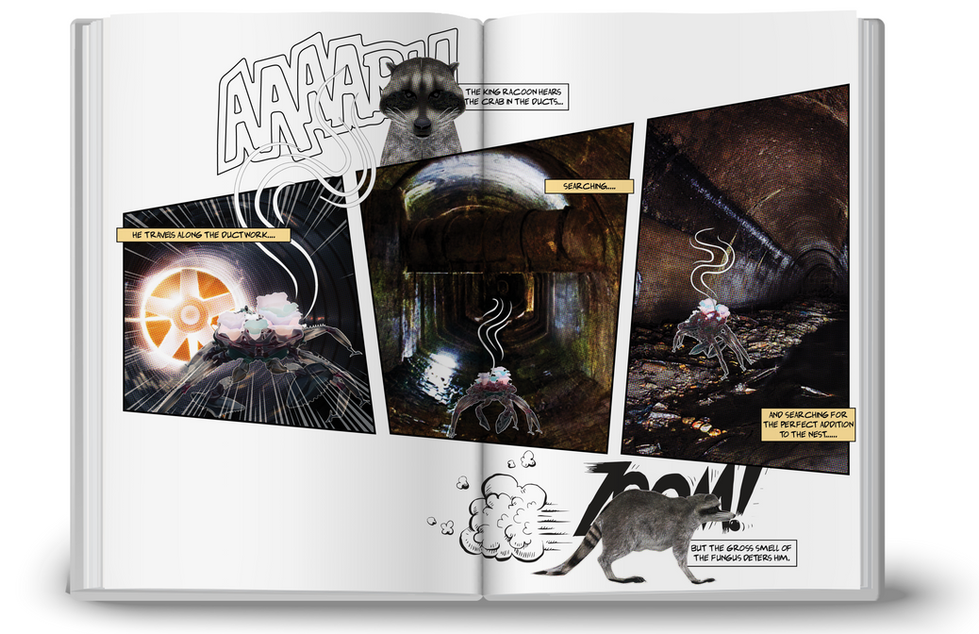2021
CALIFORNIA DUCT CRAB
Genesis of Ecologies in the Post-Anthropocene
The crab that lives in ducts, grows fungus on its back, and gets eaten by almost everyone.
CONTEXT
ARC 920 : Advanced Architecture Studio,
Ryerson University
LOCATION
Transamerica Pyramid,
Post-Anthropocene San Francisco
SOFTWARE
3ds Max, Corona Render, Photoshop, Rhinoceros3D, Illustrator
SUPERVISOR
Vincent Hui
4200: the post-anthropocene.




Situated along the San Andreas fault or The Ring of Fire, the San Francisco area is known for active volcanoes and frequent earthquakes. The city is built upon landfills and historic marshland which is susceptible to ground liquefication in the aftermath of a major earthquake. Scientists begin to explore the possibilities of cross-breeding Giant Sequoia trees with Strangling Figs to support the infrastructure of the city. By interbreeding these two species of flora, scientists of the past were able to develop a revolutionary form of infrastructure, which was able to structurally support the city, raise it above sea level and densify it.
In the Apex of civilization, San Francisco’s architecture became composed of a combination of living organisms and manufactured materials. Architecture entered a new era, when chemistry, biology, and engineering dominated the industry, using nature as a vehicle for urbanism. Along with the introduction of vegetation into the city, various fungi begin to invade urban spaces. Eventually, the city becomes unlivable due to the overgrowth of harmful fungi, leaving San Francisco devoid of human presence. The fissures and canyons created by the initial earthquake widens and along with the influx of extreme weather conditions, the up-keep of the expansive root system stops and water consumes major coastal areas. Buildings, wrapped in the cross-bred plantings, were invaded by creatures and plants, becoming natural habitats, originally constructed by human beings. The fungal growths on trees aid the trees in their growth and development. Three unique ecosystems formed by the combination of sequoia trees and urban remnants emerge, creating a mangrove-like condition in the city. Creatures begin to inhabit the marine, terrestrial and avian environments.
The city has been reclaimed by nature.
Meet Ornata Cancer Ardentem
Emerging from the ductwork of the overgrown city of San Francisco, this crab species is a delicious treat for many. As a terrestrial creature, the crab inhabits confined and dark spaces within the overgrown built environment of which, duct systems and pipes are its ideal choice. The Duct crab species evolved from the blue crab, as they began to develop unique characteristics, such as more agile pincers and rust coloring to aid with camouflage. Due to the abundance of fungus, the cause of the human’s mass exodus centuries before, the crab begins to develop a symbiotic relation with one particular species – the Glowing Duct Fungus. This fungus has a lack of chitin, which is very abundant in the crabs’ shell, so it begins to inhabit the backs of the crabs. Upon molting, a fungal build-up emerges in the crab’s nest, which then is able to serve as the crab’s food. The more the crab molts and grows, the more fungus they generate for consumption. Where previously, ducts served as a means to transport air and wasted real estate, the Duct Crabs are able to capitalize on the opportunities and protection these spaces offer. They collect various pieces or garbage and tree bark to compose their nest, which serve as their home base where they are hiding, mating, and molting. The crab’s survival is perilous. Out of the thousands of eggs laid, only a handful of the crabs survive into adult hood. However, their numbers still grow, and they are able to continue to thrive in their dark, damp and safe duct nests.





















